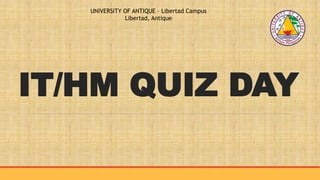
QuizDay.pptx
- 1. IT/HM QUIZ DAY UNIVERSITY OF ANTIQUE – Libertad Campus Libertad, Antique
- 2. Rules and Regulations Contestants must be a bonafide students of University of Antique – Libertad Campus. Five (5) contestants from each year level. Contest proper will be composed of 3 rounds. Twenty Five (25) questions are from general education subjects. For easy round and average round will be composed of ten (10) questions with given choices. Each question shall be given a predetermined number of points corresponding for its round. For easy round, 1 point for each correct answer and 10 seconds allotted time to answer. Contestant will answer the same set of questions in writing. Before a question is read, the contestant must raise their right hand. Each contestant will be provided with a writing board, chalk and eraser. The question will be read twice by the Quiz Master. Afterwards, he shall say “GO” only then the contestants may start writing their answer and at the same time, the countdown timer starts. After the time allotted for the specific questions, the buzzer/bell will ring will stop to write their answer and the contestant will wait for the quiz master to say “ANSWERS UP” and show their answer.
- 3. EASY ROUND UNIVERSITY OF ANTIQUE – Libertad Campus Libertad, Antique
- 4. 1. Who implemented "Tagalog" as the national language of the Philippines? A. Lapu-Lapu B. Manuel L. Quezon C. Jose P. Rizal D. Diosdado Macapagal
- 5. 2. World War II was known as the invasion of the Philippines by who? A. Japanese B. American C. Spanish D. German
- 6. 3. The colonial era of the Philippines started when a Portuguese explorer had arrived in 1521. What was the name of the explorer? A. Christopher Columbus B. Vasco da Gama C. Ferdinand Magellan D. James Cook
- 7. 4. Who named the Philippines "Las Islas Filipinas?" A. Ferdinand Magellan B. King Philip II C. Sebastian Elcano D. Ruy Lopez De Villalobos
- 8. 5. Who is the first president of the Philippines during the Third Republic? A. Emilio F. Aguinaldo B. Jose P. Laurel C. Manuel A. Roxas D. Corazon C. Aquino
- 9. 6. What is considered the earliest form of writing in the Philippines? A. Alibata B. Cuneiform C. Baybayin D. Calligraphy
- 10. 7. Who is the first editor of La Solidaridad? A. Marcelo H. Del Pilar B. Mariano Ponce C. Graciano Lopez- Jaena D. Antonio Luna
- 11. 8. Who composed the National anthem of the Philippines? A. Jose Palma B. Julian Felipe C. Jose P. Laurel D. Jose Rizal
- 12. 9. What is the name of the biggest part of the human brain? A. Cerebellum B. Cerebrum C. Medulla Oblongata D. Frontal Lobe
- 13. 10. What is the human body’s biggest organ? A. Stomach B. Skin C. Heart D. Lungs
- 14. AVERAGE ROUND UNIVERSITY OF ANTIQUE – Libertad Campus Libertad, Antique
- 15. 1. Being an archipelagic nation, the Philippines is made up of numerous islands grouped into three: Luzon, Visayas, and Mindanao. How many islands is the Philippines made up of? A. 7,107 B. 7,707 C. 7,583 D. 7,641
- 16. 2. The Philippines is known to be a religious country, with religious structures and artefacts all around the country. Among all religions present in the country, majority of the population is adherent to one. Which is the predominant religion of the Philippines?. A. Buddhism B. Islam C. Christianity D. Judaism
- 17. 3. After the country’s independence from Spain, the Philippines has been run by Filipino presidents who head both the government and the state. So far, how many presidents have led the Philippines? A. 12 B. 13 C. 16 D. 17
- 18. 4. What do we call the energy transferred between two systems by virtue of temperature difference? A. Kinetic Energy B. Mechanical Energy C. Heat Energy D. Potential Energy
- 19. 5. Government organizations set up for a specific purpose such as, the management of resources, financial oversight of industries or national security issues. Which among the government agency gives weather reports? A. Philippine Institute of Volcanology and Seismology B. Philippine Atmospheric, Geophysical and Astronomical Services Administration C. The Department of Social Welfare and Development D. National Disaster Risk Coordinating Council
- 20. 6. In the diagram you will observe different human activities that causes different effects in our environment. Identify the results of that condition where heat is trapped by gases that gather above the Earth, causing an increase in the earth's temperature. A. Emission B. Global Warming C. El Ñino D. La Ñina
- 21. 7. For how many years did Spanish rule last in the Philippines? A. 330 years B. 313 years C. 333 years D. 323 years
- 22. 8. Who wrote the "Kartilya ng Katipunan”? A. Emilio Jacinto B. Andres Bonifacio C. Jose Rizal D. Apolinario Mabini
- 23. 9. Who created the designs for the Philippine national flag? A. Emilio Aguinaldo B. Andres Bonifacio C. Jose Rizal D. Apolinario Mabini
- 24. 10. Who is the first president of the Katipunan. A. Andres Bonifacio B. Teodoro Plata C. Deodato Arellano D. Jose Dizon
- 25. DIFFICULT ROUND UNIVERSITY OF ANTIQUE – Libertad Campus Libertad, Antique
- 26. 1. What was the first book published in the Philippines? DOCTRINE CHRISTIANA
- 27. 2. What do you call an atom that has more protons than electrons? CATION
- 28. 3. In what year was Dr. Jose Rizal executed? 1896
- 29. 4. It is an umbrella term comprising past events as well as the memory, discovery, collection, organization, presentation, and interpretation of these events. HISTORY
- 30. 5. This famous work was written by Emilio Jacinto and this is the fundamental teachings of the Katipunan. KARTILYA